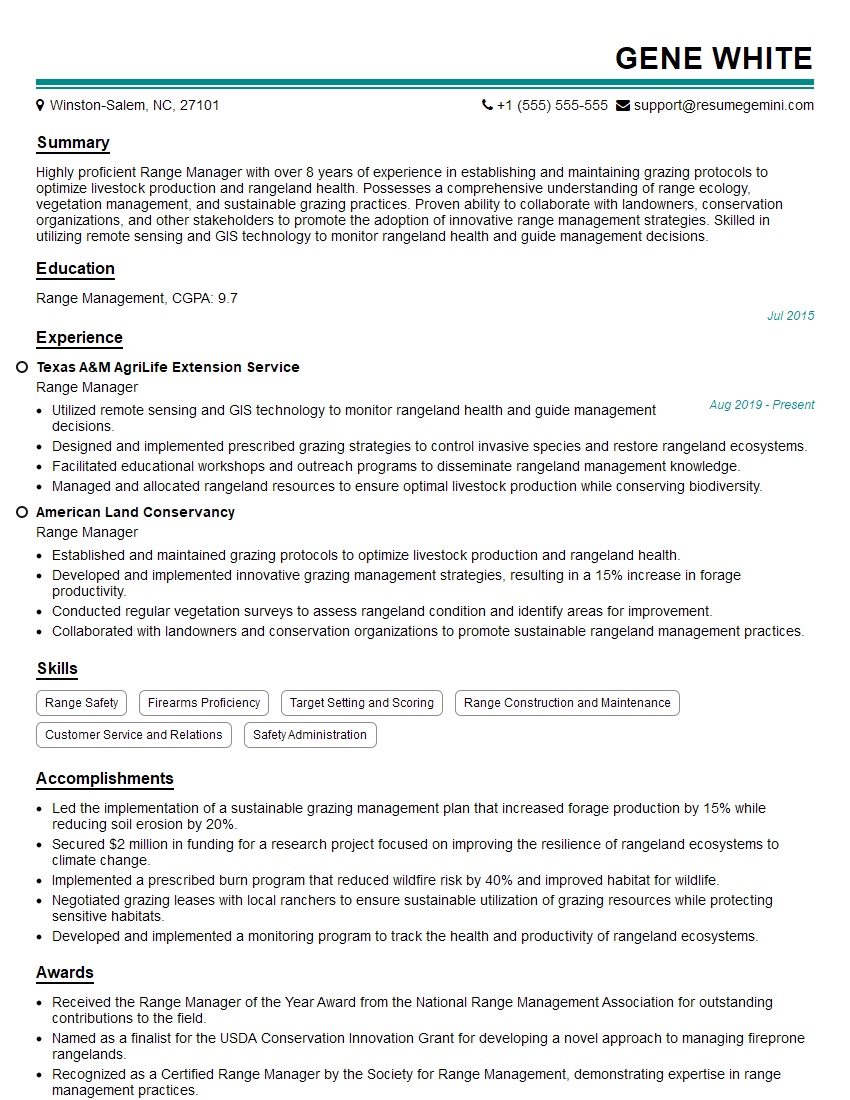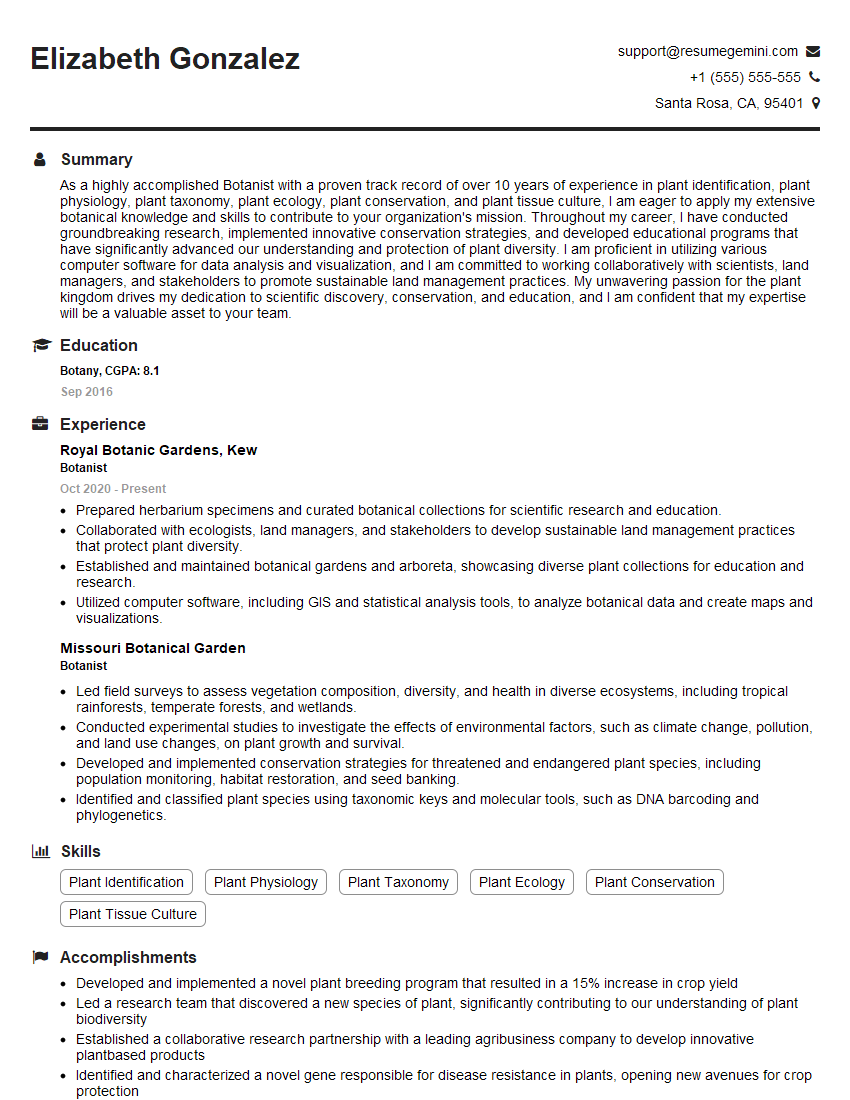Every successful interview starts with knowing what to expect. In this blog, we’ll take you through the top Plant community dynamics interview questions, breaking them down with expert tips to help you deliver impactful answers. Step into your next interview fully prepared and ready to succeed.
Questions Asked in Plant community dynamics Interview
Q 1. Describe the concept of plant community succession.
Plant community succession is the gradual and continuous change in species composition and structure of a plant community over time. Imagine a field slowly transforming into a forest – that’s succession in action! It’s a directional process driven by interactions between species and their environment, ultimately leading to a relatively stable state known as a climax community. This doesn’t mean the community is static; it’s constantly adjusting to subtle changes, but the overall dominant species remain relatively consistent. Succession can be viewed as a series of stages, each characterized by specific species adapted to the prevailing conditions.
- Early successional species (pioneer species): These are the first to colonize a site, often characterized by rapid growth, high seed production, and tolerance to harsh conditions. Think of hardy weeds quickly establishing themselves in a disturbed area.
- Mid-successional species: These species replace pioneers, often exhibiting slower growth but greater competitive ability. They are better at utilizing resources than pioneers.
- Late successional species (climax species): These are the dominant species in the mature community, often characterized by long lifespans and shade tolerance. In a forest, this might include large trees.
Understanding succession is crucial for conservation efforts, predicting ecosystem responses to disturbances, and managing vegetation for specific purposes, like restoring degraded lands.
Q 2. Explain the role of disturbance in shaping plant communities.
Disturbances are events that alter plant communities by changing resource availability, species interactions, and habitat structure. Think of disturbances as significant disruptions to the ‘normal’ flow of succession. These can range from small-scale events like a fallen tree creating a gap in a forest canopy to large-scale events like wildfires or hurricanes. The intensity, frequency, and scale of disturbances greatly influence the trajectory and outcome of succession.
- Small-scale disturbances: These create opportunities for individual species to establish or expand their populations within an existing community. They maintain biodiversity by preventing any single species from completely dominating.
- Large-scale disturbances: These can drastically alter or even reset a community, initiating primary or secondary succession. For example, a volcanic eruption completely strips the land of vegetation, resetting the successional clock.
The effect of a disturbance depends on its context. A fire in a grassland might be essential for maintaining biodiversity and preventing the encroachment of woody species, whereas the same fire in a rainforest could have devastating long-term consequences.
Q 3. What are the key factors influencing plant species diversity?
Plant species diversity, encompassing both richness (number of species) and evenness (relative abundance of species), is influenced by a complex interplay of factors. It’s like a recipe with many ingredients!
- Environmental heterogeneity: A diverse range of habitats within a landscape (e.g., varying soil types, moisture levels, sunlight exposure) supports a greater number of species. Think of a mountainous region compared to a flat plain.
- Disturbance regimes: As mentioned before, disturbances create opportunities for less competitive species to establish themselves, preventing any one species from completely dominating.
- Resource availability: Sufficient resources like water, nutrients, and light promote greater species richness. However, an overabundance of resources can lead to dominance by a few highly competitive species, reducing evenness.
- Species interactions: Competition, predation, mutualism, and other interactions shape species composition and influence diversity. For example, the presence of pollinators greatly affects the diversity of flowering plants.
- Historical factors: Past events, such as glacial cycles or human activities, can leave a lasting impact on the species pool present in a given area.
Understanding these factors is crucial for biodiversity conservation and ecosystem management strategies.
Q 4. Differentiate between primary and secondary succession.
Primary and secondary succession represent distinct pathways of community change following disturbance. The key difference lies in the starting point.
- Primary succession: This occurs on sites that have been completely stripped of life, such as bare rock exposed after a volcanic eruption or a newly formed glacial moraine. It starts with the colonization of pioneer species that can tolerate harsh conditions and gradually modify the environment, making it suitable for other species. It’s a slow process, starting from nothing!
- Secondary succession: This occurs on sites where vegetation has been removed but some soil and organic matter remain. Examples include areas cleared by fire, logging, or agricultural abandonment. The process is typically faster than primary succession because a seed bank and existing soil organisms already exist.
Imagine a forest fire: the fire clears the vegetation, leaving behind soil—this is secondary succession. However, a volcanic eruption that leaves behind bare rock initiates primary succession.
Q 5. Describe different methods for assessing plant community structure.
Assessing plant community structure involves quantifying various aspects of vegetation. Several methods are employed, depending on the research question and scale.
- Quadrat sampling: This involves placing square frames (quadrats) of a known size randomly within the area of interest. Within each quadrat, species are identified and their abundance or cover is measured. This data provides information about species richness, evenness, and density.
- Transects: A line transect involves laying a long line across the area and recording species along the line at regular intervals. This is useful for assessing changes in community structure across environmental gradients.
- Remote sensing: Techniques like aerial photography and satellite imagery can be used to map vegetation types and assess community structure over large areas. Data is often analyzed using GIS software.
- Point-quarter sampling: In this method, points are established randomly, and the nearest individual of each species is identified and measured within four quadrants around the point.
The choice of method depends on the research question, the scale of the study, and the resources available.
Q 6. How do you use vegetation indices (e.g., NDVI) in plant community analysis?
Vegetation indices like the Normalized Difference Vegetation Index (NDVI) are derived from remote sensing data and provide a quantitative measure of vegetation ‘greenness’. NDVI is calculated as (NIR - Red) / (NIR + Red), where NIR is near-infrared reflectance and Red is red reflectance. Healthy, actively photosynthesizing vegetation reflects more NIR light than red light, resulting in a high NDVI value.
In plant community analysis, NDVI can be used to:
- Monitor vegetation cover and biomass: Changes in NDVI over time can reflect changes in community structure and productivity.
- Map vegetation types: Different vegetation types have distinct NDVI signatures.
- Assess the impact of disturbances: Changes in NDVI can indicate the severity and extent of disturbances like wildfires or droughts.
- Monitor the success of restoration efforts: Increases in NDVI over time can signify successful restoration of degraded vegetation.
However, it’s important to remember that NDVI is only an indirect measure of vegetation characteristics and can be influenced by factors other than vegetation cover, such as soil moisture and atmospheric conditions. Therefore, it’s crucial to interpret NDVI data carefully in conjunction with other ground-based measurements.
Q 7. Explain the concept of niche partitioning in plant communities.
Niche partitioning is a process where coexisting species minimize competition by utilizing different resources or occupying different habitats or microhabitats within a community. It’s like sharing resources efficiently. Imagine a group of students needing to use a single library; niche partitioning would be like some students preferring the quiet corner for studying, while others opt for group study areas. They are all using the same library (resource) but in different ways.
In plant communities, niche partitioning can occur along several axes:
- Resource partitioning: Species may specialize on different nutrients, water sources, or light levels.
- Spatial partitioning: Species may occupy different vertical layers (e.g., canopy, understory) or horizontal locations (e.g., different slopes or soil types) within a community.
- Temporal partitioning: Species may have different flowering or fruiting seasons, minimizing competition for pollinators or seed dispersers.
Niche partitioning is crucial for maintaining species diversity in communities where resources are limiting. It allows multiple species to coexist and contribute to the overall ecosystem function. Without niche partitioning, competition might lead to competitive exclusion—where one species outcompetes all others, resulting in lower biodiversity.
Q 8. Discuss the impact of climate change on plant community composition.
Climate change significantly alters plant community composition through a multitude of mechanisms. Think of it like shifting the rules of a complex game. Changes in temperature and precipitation patterns directly affect species’ survival and reproduction. For example, increased temperatures can lead to drought stress in previously suitable habitats, causing species adapted to cooler, wetter conditions to decline. Simultaneously, species better suited to warmer, drier environments may expand their range.
Furthermore, altered disturbance regimes, such as increased frequency and intensity of wildfires or changes in the timing of seasonal events like frost, can dramatically reshape plant communities. Consider the boreal forests: increased wildfire frequency due to warmer, drier summers could drastically shift the composition from conifer-dominated landscapes to shrublands or grasslands.
Ultimately, climate change-induced shifts in plant communities can have cascading effects on entire ecosystems, impacting biodiversity, ecosystem services (like carbon sequestration and pollination), and human livelihoods. Understanding these impacts is crucial for effective conservation and management strategies.
Q 9. How do you identify invasive plant species and assess their impact?
Identifying invasive plant species requires a multi-faceted approach. First, we must determine whether a plant is indeed ‘non-native’ to the region –meaning it has been introduced by humans, either intentionally or unintentionally. Then, we assess its potential for spread and impact. Characteristics like rapid growth, prolific seed production, and the ability to thrive in disturbed habitats indicate high invasiveness.
Assessing their impact involves monitoring changes in native species abundance and diversity, ecosystem processes, and potentially, economic impacts. For instance, we may quantify changes in native plant cover after the introduction of an invasive species. We might also document its impact on pollination by observing native insects’ interactions with both native and invasive plants. Economic costs can include reduced crop yields, increased maintenance expenses, or damage to infrastructure. We can even use modeling approaches to project future impacts based on current invasion rates and species characteristics.
For example, the introduction of kudzu vine (Pueraria montana) in the southeastern United States resulted in significant ecological and economic damage. It blankets native vegetation, reducing biodiversity and impacting forest regeneration.
Q 10. Describe methods for monitoring plant community change over time.
Monitoring plant community change over time involves repeated surveys using a combination of methods. Think of it like taking snapshots of a landscape at regular intervals to see how it evolves.
- Permanent plots: Establishing permanent plots allows for repeated measurements at the same location, offering detailed insights into changes within a specific area. This provides strong evidence of community dynamics over time.
- Remote sensing: Aerial photography or satellite imagery can provide large-scale, synoptic views of vegetation changes over time, although it might not resolve individual species at high spatial resolution.
- Species-specific monitoring: Focusing on indicator species – those highly sensitive to environmental change – allows for early detection of shifts in the community. For example, monitoring changes in the abundance of a specific wetland species could indicate shifts in water availability.
- Data analysis: Techniques like time-series analysis and ordination methods (like PCA or RDA) help visualize and interpret long-term changes in community composition and diversity. Statistical modelling allows us to isolate the impact of different factors driving community change.
Combining these methods provides a comprehensive picture of community dynamics, informing conservation and management strategies.
Q 11. What are the challenges in restoring degraded plant communities?
Restoring degraded plant communities faces numerous challenges. It’s like trying to rebuild a complex puzzle with missing pieces and unpredictable weather.
- Identifying limiting factors: Determining the root causes of degradation (e.g., soil erosion, pollution, invasive species) is crucial. We must understand which processes need to be addressed first.
- Seed availability and germination: Sourcing seeds of native species, ensuring sufficient seed viability, and facilitating successful germination can be challenging, especially for rare or endangered species.
- Competition from invasive species: Invasive species often outcompete native plants, hindering restoration efforts. Effective control measures are essential.
- Environmental conditions: Restoring degraded sites often requires improving soil quality, controlling erosion, and restoring proper hydrological regimes. These processes can take time and resources.
- Funding and logistical constraints: Large-scale restoration projects require substantial funding, expertise, and logistical planning.
Successful restoration requires a holistic approach that considers all these challenges and incorporates adaptive management strategies to adjust to unexpected outcomes.
Q 12. Explain the role of competition in plant community dynamics.
Competition is a fundamental driver of plant community dynamics, analogous to a constant struggle for resources. Plants compete for essential resources like light, water, and nutrients. This competition shapes community structure and influences species coexistence.
Mechanisms of competition: Plants can compete directly through aggressive growth or indirectly by altering resource availability. For instance, a tall tree shades smaller understory plants, limiting their access to light. Alternatively, a plant with extensive root systems may deplete soil nutrients, hindering the growth of nearby plants.
Consequences of competition: Competition can lead to species exclusion, where dominant competitors displace less competitive species. It can also promote niche differentiation, where species evolve different strategies to access resources, leading to increased diversity. For example, different plant species may develop distinct root systems to access water at different soil depths, reducing direct competition for water.
Q 13. How does soil type influence plant community composition?
Soil type profoundly influences plant community composition. Think of it as the foundation upon which the plant community is built. Different soil properties – texture, pH, nutrient content, water-holding capacity – directly affect plant growth and survival.
Soil texture: Sandy soils, for example, are well-drained but poor in water-holding capacity, favoring drought-tolerant species. Clay soils, on the other hand, retain water but can be poorly aerated, favoring plants adapted to waterlogged conditions.
Soil pH: Soil pH affects nutrient availability. Acidic soils may limit the availability of certain nutrients, whereas alkaline soils may have different limitations. Plants have varying tolerances to soil pH, leading to distinct species assemblages in different soil pH environments.
Nutrient content: Nutrient-rich soils support lush vegetation with high species diversity, while nutrient-poor soils support plant communities adapted to low nutrient conditions. These adaptations can involve specialized root systems or symbiotic relationships with mycorrhizal fungi.
Q 14. Describe various techniques for sampling plant communities.
Sampling plant communities requires a combination of techniques to obtain representative data. The choice of technique depends on the research question, the scale of the study, and the community’s characteristics.
- Quadrats: Using square or rectangular frames of a specific size (e.g., 1m x 1m), we randomly place them within the community, recording the species and abundance within each quadrat. This method is particularly useful for smaller-scale studies.
- Transects: Establishing lines across the area of interest, we sample plant communities at regular intervals along the transect. This is useful for studying environmental gradients and species distributions.
- Point sampling: A sampling technique where data are collected at regularly spaced points. The species at each point is recorded. This is an efficient method for detecting the presence of species.
- Remote sensing: Using aerial photography or satellite imagery, we can obtain large-scale data on vegetation cover and species composition, often useful for landscape-level studies. This method frequently provides a synoptic view prior to more intensive ground-truthing.
Careful consideration of sample size and spatial distribution is crucial to obtain statistically reliable data representative of the community being studied.
Q 15. Explain the use of ordination techniques in plant community analysis.
Ordination techniques are multivariate statistical methods used in plant community analysis to visualize and interpret complex relationships between plant species and environmental gradients. Imagine you have a dataset showing the abundance of many plant species across numerous sampling sites. It’s hard to see patterns with just a table of numbers. Ordination helps condense this high-dimensional data into a lower-dimensional space (often 2D or 3D), allowing us to visually explore species associations and the environmental factors driving them.
Common ordination methods include Principal Components Analysis (PCA) and Correspondence Analysis (CA). PCA is suitable for data with normally distributed species abundances, while CA is better for species count data that are often skewed and non-normal. These techniques create axes that represent gradients of environmental conditions (e.g., soil moisture, nutrient availability, elevation) or species composition. Species and sites are then plotted along these axes, revealing clusters of similar species or sites and the environmental factors influencing their distribution.
For example, a PCA might reveal that sites with high soil moisture tend to have species like sedges and rushes grouped together, while drier sites have grasses and drought-tolerant shrubs clustered separately. This visualization helps us understand the environmental drivers structuring the plant community.
Career Expert Tips:
- Ace those interviews! Prepare effectively by reviewing the Top 50 Most Common Interview Questions on ResumeGemini.
- Navigate your job search with confidence! Explore a wide range of Career Tips on ResumeGemini. Learn about common challenges and recommendations to overcome them.
- Craft the perfect resume! Master the Art of Resume Writing with ResumeGemini’s guide. Showcase your unique qualifications and achievements effectively.
- Don’t miss out on holiday savings! Build your dream resume with ResumeGemini’s ATS optimized templates.
Q 16. Discuss the application of GIS in plant community mapping and analysis.
Geographic Information Systems (GIS) are invaluable tools for plant community mapping and analysis, enabling spatial visualization, analysis, and modeling of vegetation patterns. GIS allows us to integrate various spatial data layers, including vegetation surveys, satellite imagery, elevation data, and soil maps, to create detailed vegetation maps and investigate spatial relationships.
For example, we can overlay vegetation survey data on a topographic map to see how plant communities vary with elevation. Similarly, we can use remotely sensed data (e.g., from Landsat or Sentinel satellites) to classify vegetation types across large areas and monitor changes in vegetation cover over time. GIS also facilitates spatial statistical analyses, such as spatial autocorrelation analysis to assess the spatial patterns of species diversity or the impact of habitat fragmentation on plant communities.
Imagine a project aimed at conserving a rare plant species. GIS can be used to map the species’ current distribution, identify suitable habitats based on environmental variables, and model potential future distribution under climate change scenarios. This information can inform conservation strategies such as habitat restoration or assisted migration.
Q 17. How do you interpret a species-area curve?
A species-area curve illustrates the relationship between the area sampled and the number of species found. It’s a fundamental concept in ecology and biogeography, helping us understand how species richness changes as the size of the habitat increases. The curve typically starts steep, as new species are encountered rapidly in the initial sampling. As the area sampled increases, the curve gradually flattens, indicating that additional sampling reveals fewer new species.
Interpreting a species-area curve involves analyzing its shape and parameters. A steeper curve suggests higher species turnover (i.e., many different species across the landscape), whereas a flatter curve might suggest lower turnover or perhaps that the sampling has already encompassed most of the species present in the area. The curve’s parameters can be used to estimate species richness (the total number of species in the area) by extrapolating beyond the sampled area. However, this extrapolation must be approached cautiously, as it assumes that the relationship between area and species richness remains consistent beyond the sampled range, which isn’t always the case.
For instance, a species-area curve for a tropical rainforest would likely be steeper than one for a temperate grassland, reflecting the higher species richness and turnover rates in the rainforest.
Q 18. Explain the importance of biodiversity in plant communities.
Biodiversity in plant communities is paramount for ecosystem functioning and resilience. A diverse plant community offers a range of ecosystem services, including increased productivity, enhanced nutrient cycling, improved water retention, and greater resistance to disturbances like drought or disease. Higher diversity often translates to a more stable ecosystem, better able to withstand environmental stresses and recover from disturbances.
For example, a diverse plant community is more likely to have species adapted to various environmental conditions, such as drought-tolerant species, shade-tolerant species, and nutrient-efficient species. This functional diversity buffers the ecosystem against environmental fluctuations. Furthermore, diverse plant communities support a greater variety of other organisms, enhancing overall biodiversity and ecosystem complexity.
Loss of biodiversity, on the other hand, can lead to ecosystem simplification, reduced resilience, and decreased ecosystem services. Think of monoculture farming, where a single crop species dominates the landscape. This lack of diversity makes the system vulnerable to pests and diseases, potentially leading to significant crop losses.
Q 19. What are the different types of plant life forms and their ecological roles?
Plant life forms categorize plants based on their structure and growth habit. These categories reflect adaptations to different environments and play critical roles in ecosystem functioning. Common life forms include:
- Trees: Woody plants with a single, persistent stem.
- Shrubs: Woody plants with multiple stems arising from the base.
- Herbs: Non-woody plants with relatively soft stems that often die back to the ground annually.
- Grasses: Herbaceous plants with characteristic narrow leaves and nodes.
- Forbs: Non-woody, non-grass herbs.
- Climbers/Lianas: Plants with climbing stems that depend on other plants for support.
- Succulents: Plants adapted to arid conditions with specialized tissues for water storage.
Each life form contributes uniquely to the ecosystem. Trees, for instance, often form the dominant canopy layer, influencing light availability and microclimate. Grasses dominate grasslands, supporting grazing animals. Shrubs may provide habitat for smaller animals, while herbs and forbs contribute to soil fertility and floral diversity. The relative abundance of different life forms dictates community structure and function, highlighting how diverse forms contribute to resilience.
Q 20. How do you assess the health of a plant community?
Assessing the health of a plant community involves evaluating multiple aspects of its structure, composition, and function. A healthy community is typically characterized by high biodiversity, a well-developed structure reflecting species interactions, and efficient ecosystem processes. Assessment methods include:
- Species richness and diversity: Measuring the number and evenness of plant species.
- Community composition: Evaluating the relative abundance of different species and functional groups.
- Vegetation structure: Assessing aspects like canopy cover, height, density, and layering.
- Ecosystem processes: Monitoring nutrient cycling, productivity, and soil health.
- Indicators of stress: Looking for signs of disease, pest infestation, or other environmental pressures.
For example, a decline in species richness, the dominance of a few invasive species, or evidence of widespread disease could indicate community degradation. Conversely, a diverse community with a well-developed structure and high productivity is generally considered healthy. Remote sensing techniques, field surveys, and laboratory analyses are all used to collect data for comprehensive assessments.
Q 21. Describe the concept of functional diversity in plant communities.
Functional diversity focuses on the range of ecological functions performed by different species in a community. It goes beyond simply counting species; it examines the variety of traits related to how species acquire resources, interact with other species, and respond to environmental changes. This perspective is vital as species with similar traits might play similar functional roles, even if they are taxonomically different.
For example, several plant species might be considered ‘nitrogen fixers’ – even if they aren’t closely related – thus contributing similarly to nutrient cycling. Analyzing functional diversity involves identifying key functional traits (e.g., plant height, leaf area, root depth, specific leaf area, seed size) and assessing their distribution across the community. Functional diversity can be measured using various indices that account for both the number and evenness of functional traits.
High functional diversity is linked to improved ecosystem resilience and functioning. For instance, a community with diverse root depths will be more resistant to drought than one with only shallow-rooted species. Assessing functional diversity is crucial for understanding how plant communities respond to environmental change and for managing ecosystems for sustainability.
Q 22. How do grazing animals influence plant community structure?
Grazing animals are a powerful force shaping plant community structure. Their influence is multifaceted, affecting not just the abundance of individual plant species but also the overall diversity and composition of the community.
Selective Grazing: Grazers often prefer certain plant species over others, leading to a decrease in the abundance of palatable plants and a potential increase in less palatable or even unpalatable species. For example, sheep might heavily graze grasses, favoring them over less palatable forbs, ultimately altering the proportion of each in the community.
Biomass Reduction: Grazing directly reduces plant biomass, affecting competitive interactions. By removing dominant species, grazing can create opportunities for less competitive species to establish themselves. This is particularly significant in grasslands where competitive exclusion is a major factor.
Nutrient Cycling: Grazers’ dung deposits nutrients back into the soil, altering soil fertility and influencing plant growth. This effect can vary depending on the type and intensity of grazing.
Seed Dispersal: Some grazing animals can contribute to seed dispersal, either unintentionally through their dung or intentionally through seed hoarding behavior. This can promote plant species diversity in certain circumstances.
Vegetation Structure Alteration: Heavy grazing can lead to changes in vegetation height and cover, influencing microclimate and creating habitats for other organisms. For instance, overgrazing can lead to soil erosion and desertification, drastically changing the plant community.
Understanding the intensity and type of grazing is crucial to predicting its impact. Light grazing can promote diversity, while overgrazing can lead to community simplification and degradation.
Q 23. Explain the role of mycorrhizal fungi in plant communities.
Mycorrhizal fungi form symbiotic relationships with the roots of most plant species, playing a critical role in plant community dynamics. These fungi extend the root systems of plants, greatly enhancing their access to water and nutrients, particularly phosphorus.
Nutrient Acquisition: Mycorrhizal fungi are exceptionally efficient at absorbing nutrients from the soil, transferring them to their host plants. This is especially important in nutrient-poor environments.
Water Uptake: The extensive hyphal networks of mycorrhizal fungi increase the surface area for water absorption, conferring drought tolerance to their host plants.
Plant-Plant Interactions: Mycorrhizal networks can connect different plants, facilitating the transfer of resources (water, nutrients, even carbon) between them. This can create positive feedback loops, where plants benefit from the enhanced growth and survival of their neighbors, or negative interactions depending on the species involved and environmental conditions.
Disease Suppression: Some mycorrhizal fungi also protect their host plants from pathogens, enhancing their overall health and competitiveness.
Soil Stabilization: The fungal hyphae contribute to soil structure and aggregation, improving soil stability and reducing erosion.
The type of mycorrhizae (e.g., arbuscular mycorrhizae, ectomycorrhizae) and the specific fungal species involved can have significant impacts on plant community composition and function. Their role is particularly important in ecosystems experiencing nutrient limitations or environmental stresses.
Q 24. Discuss the impact of fire on plant community dynamics.
Fire is a natural and often crucial disturbance in many plant communities, profoundly impacting their structure and dynamics. Its effects depend on fire frequency, intensity, and seasonality, as well as the characteristics of the plant community itself.
Species Composition Changes: Fire can eliminate fire-sensitive species while favoring those adapted to fire, such as those with serotinous cones (releasing seeds after fire) or resprouting capabilities. For instance, in many pine forests, fire is essential for regeneration, as it clears the understory and allows pine seedlings to establish.
Nutrient Cycling: Fire releases nutrients tied up in dead organic matter, making them available for plant uptake. However, excessive burning can lead to nutrient loss through volatilization.
Vegetation Structure Alteration: Fire changes vegetation structure, affecting light availability, microclimate, and habitat availability for other organisms. For instance, fire can create gaps in the canopy, benefiting species that require full sunlight.
Soil Properties: Fire can impact soil properties such as water infiltration and erosion potential. Severe fires can lead to soil degradation and loss of topsoil.
Fire management is a critical aspect of plant community conservation in many ecosystems. Controlled burns can mimic natural fire regimes, promoting diversity and preventing the buildup of flammable material, thus reducing the risk of catastrophic wildfires.
Q 25. How do you use statistical methods to analyze plant community data?
Analyzing plant community data requires robust statistical methods to uncover patterns and relationships. Common approaches include:
Diversity Indices: These metrics (e.g., Shannon diversity index, Simpson’s diversity index) quantify species richness and evenness within a community.
Ordination Techniques: Methods like Principal Component Analysis (PCA) or Non-metric Multidimensional Scaling (NMDS) visualize community similarity and differences based on species abundances.
# Example R code for NMDS: library(vegan); nmds <- metaMDS(community_matrix)Multivariate Analysis of Variance (MANOVA): Tests for significant differences in community composition between groups (e.g., different treatments, locations).
Generalized Linear Models (GLMs): Model the relationship between plant species abundance or presence/absence and environmental factors (e.g., soil pH, elevation).
Generalized Additive Models (GAMs): Similar to GLMs, but can model non-linear relationships between variables.
Choosing the appropriate statistical method depends on the research question, data type, and assumptions met. It is crucial to carefully consider sample size, data transformation, and potential confounding variables when interpreting results.
Q 26. Describe different approaches to managing plant communities for conservation.
Managing plant communities for conservation involves a variety of approaches, tailored to specific ecological goals and contexts.
Habitat Restoration: Re-establishing degraded habitats to their original state through active interventions like removing invasive species, planting native plants, and improving soil conditions. This might involve historical ecological research to understand previous community structures.
Invasive Species Control: Managing or eradicating invasive plant species that threaten native biodiversity. Methods can range from manual removal to biological control.
Protected Area Management: Establishing and managing protected areas (national parks, reserves) to conserve plant communities and prevent habitat loss. This often includes fire management and control of human impacts.
Sustainable Resource Management: Implementing practices such as sustainable forestry or grazing that minimize negative impacts on plant communities while allowing for resource extraction.
Assisted Migration: Relocating plant species to new areas in response to climate change, where they are likely to survive and thrive. This approach involves careful consideration of potential risks and ethical implications.
Effective plant community management requires a holistic, adaptive approach, involving monitoring, evaluation, and adjustment of management strategies over time.
Q 27. What are the ethical considerations in plant community research and management?
Ethical considerations are paramount in plant community research and management. These include:
Informed Consent: Respecting the rights and interests of Indigenous peoples and local communities, particularly when research involves their traditional lands or knowledge.
Data Transparency and Sharing: Making research data openly accessible to promote collaboration and avoid duplication of effort. Respecting intellectual property rights is also crucial.
Environmental Impact Assessment: Minimizing the environmental footprint of research and management activities, such as avoiding habitat destruction or disturbance of sensitive species.
Biodiversity Conservation: Prioritizing actions that enhance biodiversity and ecosystem resilience, rather than actions that may benefit only a few selected species.
Conflict of Interest: Avoiding situations where personal or financial interests might compromise the objectivity of research or management decisions.
Ethical practices ensure that plant community research and management contributes positively to both ecological and social well-being.
Q 28. Explain how you would design a study to investigate the effects of a specific environmental factor on plant community composition.
To investigate the effects of a specific environmental factor on plant community composition, I would design a study involving the following steps:
Define the research question and hypotheses: Clearly articulate the specific environmental factor of interest and its expected impact on the community.
Site Selection: Choose study sites that represent a gradient in the environmental factor. For instance, if investigating the impact of elevation, sites at different elevations would be selected.
Sampling Design: Establish a rigorous sampling design to ensure adequate replication and minimize bias. This might involve random sampling, stratified random sampling or systematic sampling depending on the study.
Data Collection: Quantify plant community composition at each site using methods like quadrat sampling or point-intercept sampling. Simultaneously, measure the environmental factor of interest and other relevant variables (e.g., soil properties, climate data).
Data Analysis: Use appropriate statistical methods (e.g., GLMs, ordination techniques) to analyze the data and test the hypotheses. Assess the relationship between the environmental factor and community composition.
Interpretation and Reporting: Interpret the results in the context of existing ecological knowledge and communicate the findings in a clear and accessible manner, including limitations of the study.
Example: Investigating the impact of nitrogen deposition on grassland communities. Sites with varying levels of nitrogen deposition (e.g., near a fertilizer factory vs. remote areas) would be chosen. Plant species composition would be recorded, and the nitrogen levels in soil and vegetation would be measured. Statistical analyses would determine whether nitrogen deposition significantly alters species composition and richness.
Key Topics to Learn for Plant Community Dynamics Interview
- Succession and Disturbance: Understand the mechanisms driving plant community change over time, including primary and secondary succession, the role of disturbance events (fire, floods, etc.), and resilience concepts. Consider practical examples of how these processes affect ecosystem services.
- Species Interactions: Explore the intricacies of competition, facilitation, and mutualism within plant communities. Be prepared to discuss how these interactions influence species composition and abundance, and how they might be modeled.
- Biodiversity and Conservation: Grasp the importance of plant diversity within communities and its relationship to ecosystem stability and function. Be ready to discuss conservation strategies and the impact of habitat fragmentation and climate change.
- Community Composition and Structure: Learn to analyze and interpret data on species richness, evenness, and dominance. Understand the different methods used to measure and quantify community structure (e.g., diversity indices).
- Spatial Patterns and Landscape Ecology: Explore how spatial heterogeneity influences plant community dynamics. Understand concepts like patchiness, edge effects, and metapopulations, and their relevance to conservation and management.
- Data Analysis and Modeling: Familiarize yourself with common statistical methods used in plant community ecology, such as ordination techniques (e.g., PCA, RDA) and species distribution models. Be prepared to discuss the strengths and limitations of different approaches.
- Applied Plant Community Ecology: Consider examples of how an understanding of plant community dynamics informs practical applications like restoration ecology, invasive species management, and ecosystem-based management.
Next Steps
Mastering plant community dynamics opens doors to exciting careers in research, conservation, and environmental management. A strong understanding of these principles is highly valued by employers. To maximize your job prospects, creating a compelling and ATS-friendly resume is crucial. ResumeGemini is a trusted resource that can help you build a professional and impactful resume tailored to showcase your expertise. We provide examples of resumes specifically designed for candidates in Plant community dynamics to help you get started. Invest time in crafting a strong resume – it's your first impression on potential employers.
Explore more articles
Users Rating of Our Blogs
Share Your Experience
We value your feedback! Please rate our content and share your thoughts (optional).
What Readers Say About Our Blog
Live Rent Free!
https://bit.ly/LiveRentFREE
Interesting Article, I liked the depth of knowledge you’ve shared.
Helpful, thanks for sharing.
Hi, I represent a social media marketing agency and liked your blog
Hi, I represent an SEO company that specialises in getting you AI citations and higher rankings on Google. I’d like to offer you a 100% free SEO audit for your website. Would you be interested?









